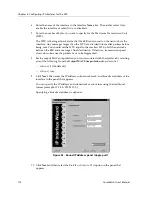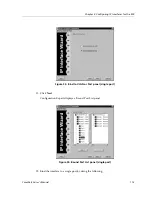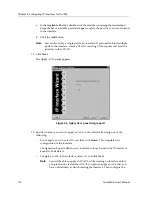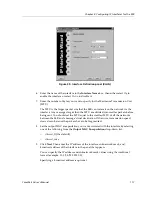
Chapter 8: Configuring IP Interfaces for the SSR
108
CoreWatch User’s Manual
on network 11.0.0.0, has a network address of 11.0.0.2. The router has two interfaces and
connects to both networks. (You can say the router is “well connected.”)
To communicate with one another through the router, the hosts make entries in routing
tables as shown in the following table. For example, host A communicates with host B by
using the route specified with the 11.0.0.0 10.0.0.1 entry in the host A routing table. That
entry states that host A uses the router at 10.0.0.1 as a gateway when it wants to
communicate with host B on the 11.0.0.0 network.
The previous table provides information about network routes rather than host routes. If
the previous table was providing information about host routes rather than network
routes, each host’s routing table would list the other host’s IP address as the destination.
When a packet is sent, the entire route is not known at the source. Instead, packets travel
to their destination one hop at a time. At each stop, a router calculates the next destination
by matching the destination address with entries in that router's routing table. This is
similar to sending a letter through the United States postal service. The envelope has the
ultimate destination address. Each post office along the way checks the ultimate
destination and determines the next-hop (the next post office). When the letter gets to the
post office that is serving the address on the envelope, the letter is delivered directly to the
address.
In addition to providing connectionless deliveries, IP fragments and reassembles packets.
IP does not guarantee that the packets will arrive in order or at all, nor does IP report
packet errors back to the source. Guarantee delivery is the responsibility of TCP, and the
reporting of packet errors is the responsibility of ICMP.
A Look at IP Addresses
When configuring the SSR, you will be required to enter IP address information. These 32-
bit addresses, which identify a
connection to a network
rather than a particular system,
include both a network ID and a host ID. If a network is part of the internet, the network
Table 10. Network destination and gateway routes
Host A
Router
Host B
Destination
Gateway
Destination
Gateway
Destination
Gateway
10.0.0.0
10.0.0.2
11.0.0.0
11.0.0.1
11.0.0.0
11.0.0.2
11.0.0.0
10.0.0.1
10.0.0.0
10.0.0.1
10.0.0.0
11.0.0.1
Host A
Host B
Router
10.0.0.0
11.0.0.0
10.0.0.2
11.0.0.1
10.0.0.1
11.0.0.2
Summary of Contents for SSR-GLX19-02
Page 1: ...CoreWatch User s Manual 9032564 04...
Page 2: ...Notice 2 CoreWatch User s Manual...
Page 20: ...Preface 20 CoreWatch User s Manual...
Page 64: ...Chapter 5 Changing System Settings 64 CoreWatch User s Manual...
Page 86: ...Chapter 6 Configuring SSR Bridging 86 CoreWatch User s Manual...
Page 106: ...Chapter 7 Configuring VLANs on the SSR 106 CoreWatch User s Manual...
Page 206: ...Chapter 12 Configuring QoS on the SSR 206 CoreWatch User s Manual...
Page 246: ...Chapter 13 Configuring Security on the SSR 246 CoreWatch User s Manual...
Page 363: ...CoreWatch User s Manual 363 Chapter 16 Configuring Routing Policies on the SSR 9 Click OK...
Page 364: ...Chapter 16 Configuring Routing Policies on the SSR 364 CoreWatch User s Manual...
Page 370: ...Chapter 17 Checking System Status 370 CoreWatch User s Manual...
Page 390: ...Chapter 18 Monitoring Real Time Performance 390 CoreWatch User s Manual...
Page 396: ...Chapter 19 Checking the Status of Bridge Tables 396 CoreWatch User s Manual...
Page 430: ...Chapter 20 Checking the Status of Routing Tables 430 CoreWatch User s Manual...
Page 442: ...Chapter 22 Obtaining Reports 442 CoreWatch User s Manual...
Page 456: ...Appendix B CoreWatch Menus 456 CoreWatch User s Manual...
















































